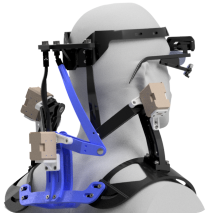Dropped head syndrome is a common problem in amyotrophic lateral sclerosis (ALS) that significantly impacts the quality of life of people with ALS. Currently, this problem is managed using static neck braces which keep the head upright by providing support under the chin. People with ALS find these uncomfortable to wear over extended periods of time. Also, their use results in challenges in speech, swallowing, and breathing.
A robotic neck brace has been developed in the Robotics and Rehabilitation (ROAR) Laboratory at Columbia University for both measurement and active assistance. This robotic neck brace enables active rotation of the head through user given inputs via keyboards, hand-held joysticks, or an eye-tracker.
The goal of this project is to investigate the feasibility and document the challenges in long-term usage of the brace, and to measure the impact of its use on patients with moderate-to-severe head drop.

